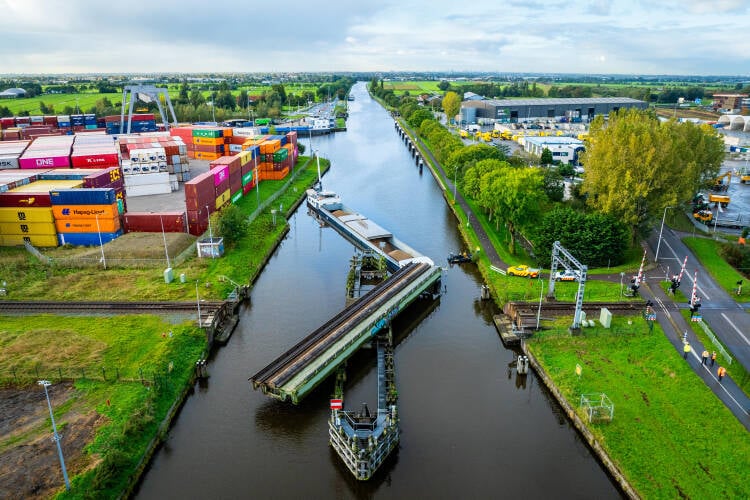
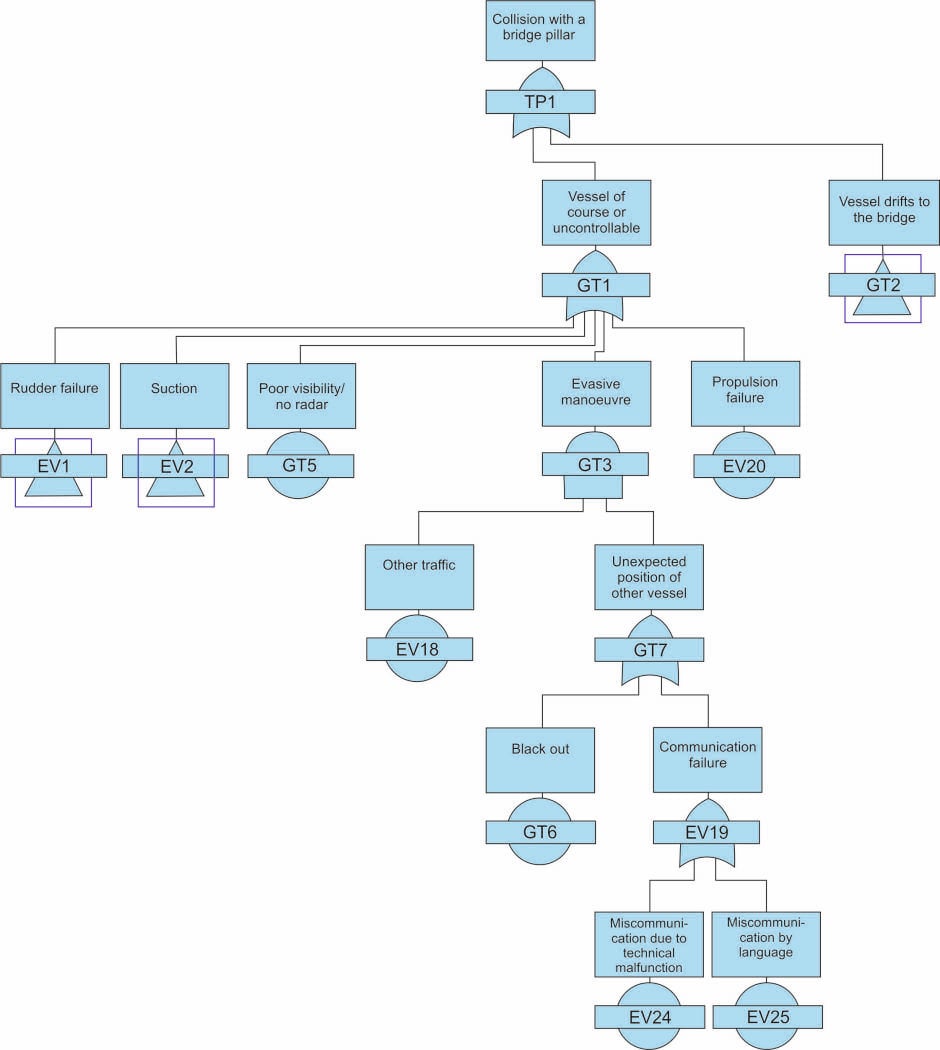
Event tree showing a chain of causes leading to a collision with a bridge pillar.

Create a MARIN account to stay updated

Report
June 2025, no. 144
Potential risk
of collisions at
bridge piers
under
scrutiny

Kennisprogramma Natte Kunstwerken geeft inzicht voor vernieuwingsopgave, Zakelijk en Innovatie | Rijkswaterstaat &, 01 2025 (Dutch only)

www.nattekunstwerkenvandetoekomst.nl

More info
Collision with rail bridge across the river Gouwe, Alphen aan den Rijn, The Netherlands. Photo: MediaTV
The Dutch government and knowledge experts, including MARIN, are teaming up to examine collision risks at ageing bridge piers in the Netherlands.
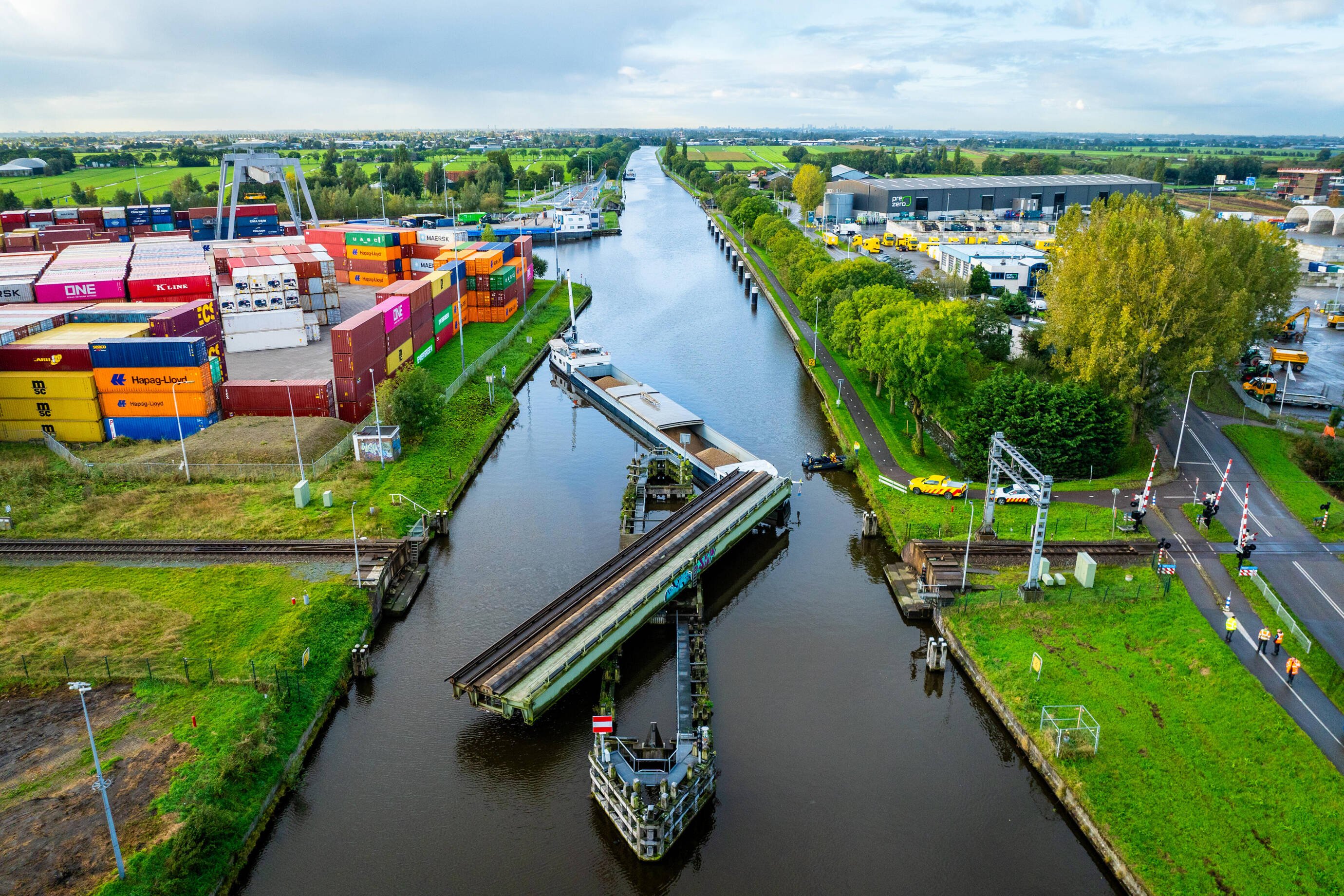
Interested? Contact us to discuss your options
In 2024, the main achievement was determining the method of collision probability and collision energy by exploring four cases. The basic principles, advantages and disadvantages of the various methods are described and summarised in an overview of lessons learned and best practices.
This year, two of the methods will be compared in more detail using the actual data of an existing bridge. In addition, the description will be expanded to include a probabilistic approach for determining the collision loads on the structure, i.e. the ultimate consequences of a collision.
In parallel to the bridge pier research, a protocol has been drawn up for the use of Automatic Identification System (AIS) data as a source of information for analysing collision risks. AIS provides, among other things, regular information about the positions, velocities and dimensions of a ship. The protocol uses the Spijkenisser Bridge (Spijkenisserbrug) as an example.
Collision load probability
AIS analysis provides insight into both the probability of a collision and the collision load probability, as well as current and historical traffic. But it does not take into account future changes in traffic composition or flows. It is often necessary to use additional data sources, and this is also addressed within the study.
New protocol
As a result, the KpNK programme has published a protocol for the use of anonymised AIS data in collision risk studies which is available from the KpNK website.
Finally, over the past years, an inventory was compiled of the probabilistic methods available for determining both the probability of collisions with bridge piers and the probability distribution of collision energy.
Developing regulations
One of the aspects that has been considered in recent years is the likelihood of bridge collisions. Over the last 10 years, 570 bridge collisions have been recorded. The aim is to develop regulations for a probabilistic approach to calculating the load on bridge piers as a result of collisions. Similar challenges apply to other infrastructure in the waterways, for example locks, weirs, and (movable) bridge decks, and it is expected that the results can also be used for these with appropriate adjustments in due course.
KpNK programme
This presents many challenges, such as determining which structures need to be addressed first and which can wait. To tackle these challenges, Rijkswaterstaat is working closely with knowledge partners MARIN, Deltares and TNO within the joint “Wet Civil Engineering Structures Knowledge Programme” (Kennisprogramma Natte Kunstwerken, KpNK).
The aim of this knowledge programme is to develop clear guidelines and tools that are easy to apply when making decisions regarding replacement or renovation, taking into account developments in shipping, climate change and technology. With MARIN examining the impact on shipping, the partners have drawn up a long-term plan covering all potential impacts. Each year the KpNK participants delve deeper into one or more topics, such as the possible causes of a collision or the use of certain data to estimate the risk of acceptance. This approach ensures that they don't just deliver isolated results; instead, collectively building up a valuable, complete picture.
Rijkswaterstaat, (the Directorate General for Public Works and Water Management), which is responsible for the design, construction, management and maintenance of the Netherlands’ primary infrastructure facilities, manages 333 bridges and 101 so-called wet civil engineering structures, such as locks and weirs. These structures must guarantee water safety but also ensure the smooth and safe passage of ships now and in the future.
However, many of these locks and bridges were built between 1950 and 1970 and are currently in the final phase of their technical design life. In addition, bridges, for example, are facing an increasing collision risk due to more intensive use and ever larger ships. As a result, many bridges, locks and weirs will need to be replaced or renovated in the coming years.
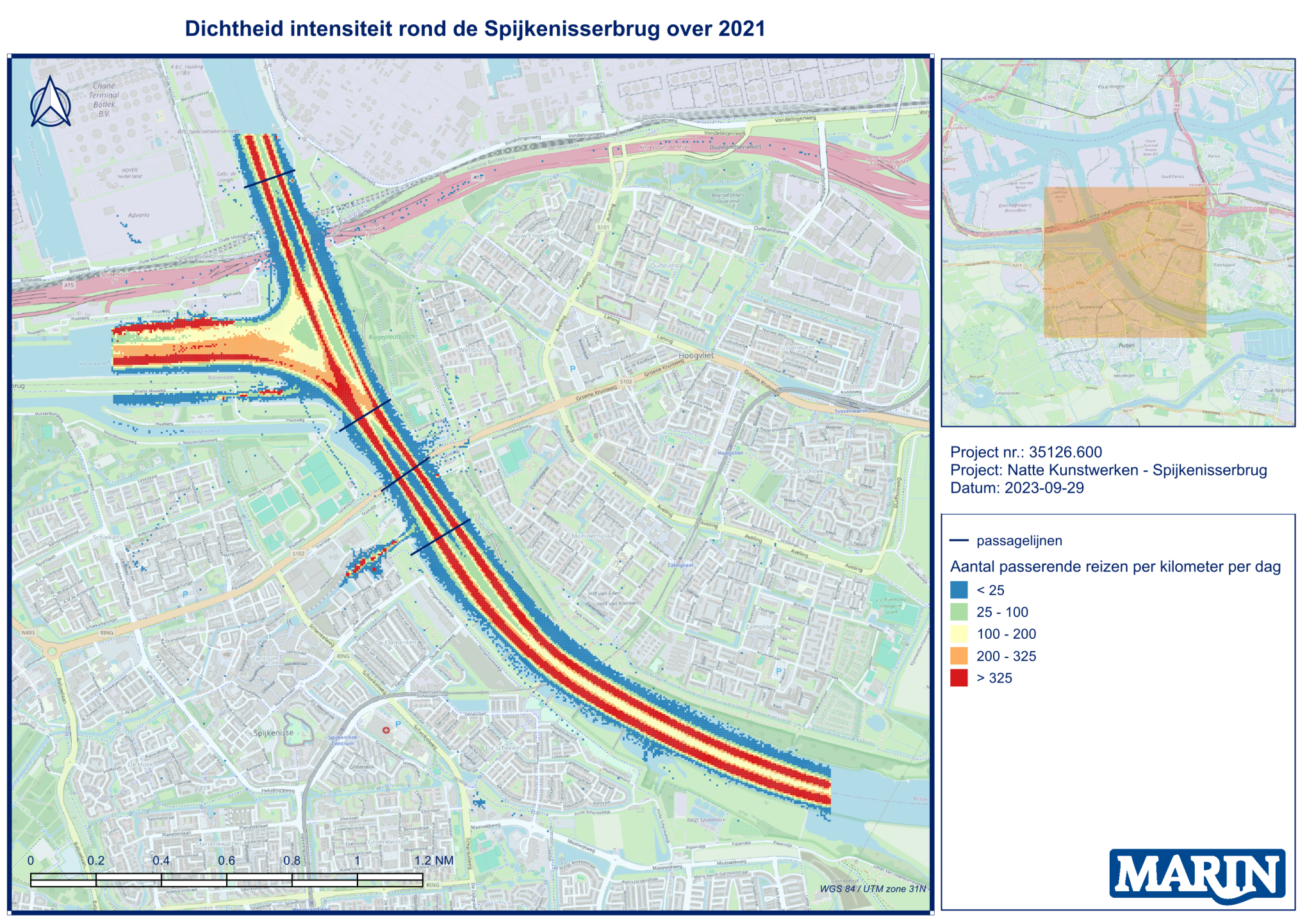
Traffic density around the Spijkenisser Bridge in 2021. Number of passing vessels per km per day.




Collision with rail bridge across the river Gouwe, Alphen aan den Rijn, The Netherlands. Photo: MediaTV

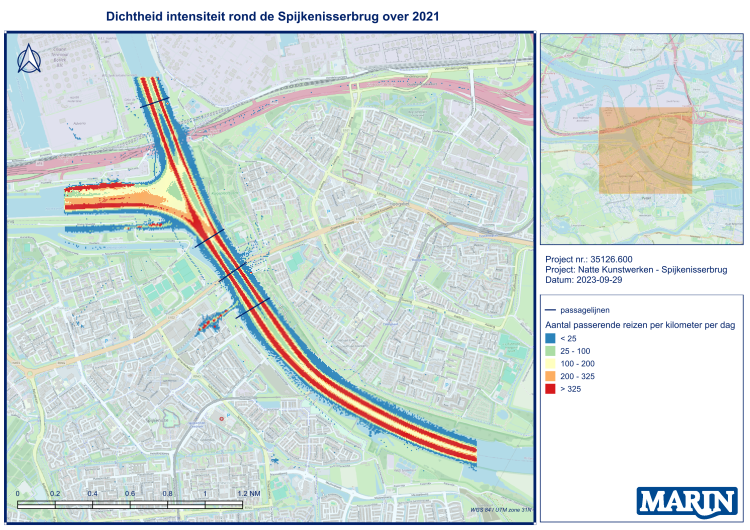
Traffic density around the Spijkenisser Bridge in 2021. Number of passing vessels per km per day.
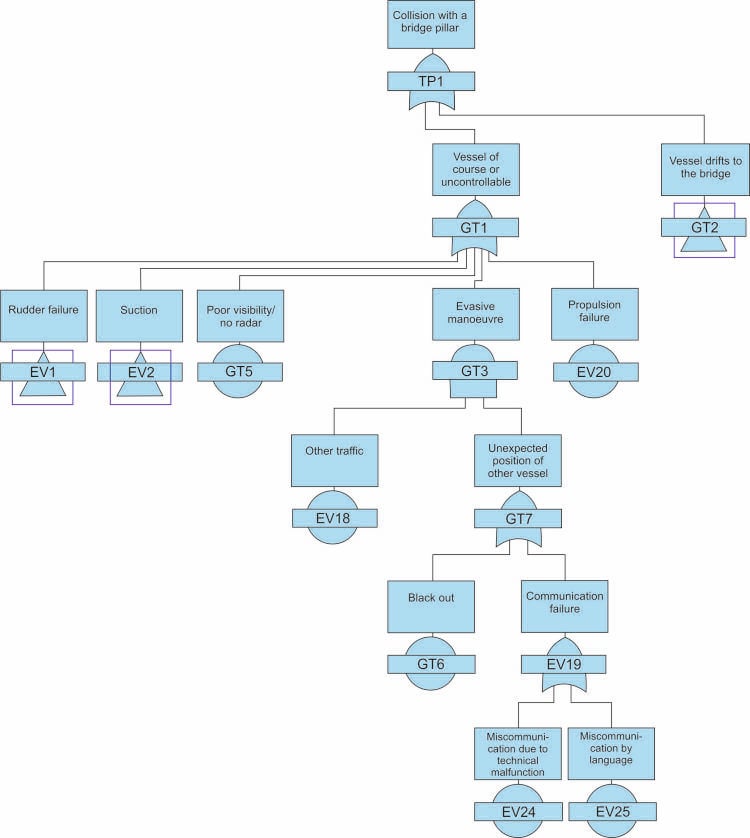
Event tree showing a chain of causes leading to a collision with a bridge pillar.

Potential risk
of collisions
at bridge piers
under scrutiny
Kennisprogramma Natte Kunstwerken geeft inzicht voor vernieuwingsopgave, Zakelijk en Innovatie | Rijkswaterstaat &, 01 2025 (Dutch only)

www.nattekunstwerkenvandetoekomst.nl

Developing regulations
One of the aspects that has been considered in recent years is the likelihood of bridge collisions. Over the last 10 years, 570 bridge collisions have been recorded. The aim is to develop regulations for a probabilistic approach to calculating the load on bridge piers as a result of collisions. Similar challenges apply to other infrastructure in the waterways, for example locks, weirs, and (movable) bridge decks, and it is expected that the results can also be used for these with appropriate adjustments in due course.
In parallel to the bridge pier research, a protocol has been drawn up for the use of Automatic Identification System (AIS) data as a source of information for analysing collision risks. AIS provides, among other things, regular information about the positions, velocities and dimensions of a ship. The protocol uses the Spijkenisser Bridge (Spijkenisserbrug) as an example.
Collision load probability
AIS analysis provides insight into both the probability of a collision and the collision load probability, as well as current and historical traffic. But it does not take into account future changes in traffic composition or flows. It is often necessary to use additional data sources, and this is also addressed within the study.
New protocol
As a result, the KpNK programme has published a protocol for the use of anonymised AIS data in collision risk studies which is available from the KpNK website.
Finally, over the past years, an inventory was compiled of the probabilistic methods available for determining both the probability of collisions with bridge piers and the probability distribution of collision energy.
More info
KpNK programme
This presents many challenges, such as determining which structures need to be addressed first and which can wait. To tackle these challenges, Rijkswaterstaat is working closely with knowledge partners MARIN, Deltares and TNO within the joint “Wet Civil Engineering Structures Knowledge Programme” (Kennisprogramma Natte Kunstwerken, KpNK).
The aim of this knowledge programme is to develop clear guidelines and tools that are easy to apply when making decisions regarding replacement or renovation, taking into account developments in shipping, climate change and technology. With MARIN examining the impact on shipping, the partners have drawn up a long-term plan covering all potential impacts. Each year the KpNK participants delve deeper into one or more topics, such as the possible causes of a collision or the use of certain data to estimate the risk of acceptance. This approach ensures that they don't just deliver isolated results; instead, collectively building up a valuable, complete picture.
Rijkswaterstaat, (the Directorate General for Public Works and Water Management), which is responsible for the design, construction, management and maintenance of the Netherlands’ primary infrastructure facilities, manages 333 bridges and 101 so-called wet civil engineering structures, such as locks and weirs. These structures must guarantee water safety but also ensure the smooth and safe passage of ships now and in the future.
However, many of these locks and bridges were built between 1950 and 1970 and are currently in the final phase of their technical design life. In addition, bridges, for example, are facing an increasing collision risk due to more intensive use and ever larger ships. As a result, many bridges, locks and weirs will need to be replaced or renovated in the coming years.
In 2024, the main achievement was determining the method of collision probability and collision energy by exploring four cases. The basic principles, advantages and disadvantages of the various methods are described and summarised in an overview of lessons learned and best practices.
This year, two of the methods will be compared in more detail using the actual data of an existing bridge. In addition, the description will be expanded to include a probabilistic approach for determining the collision loads on the structure, i.e. the ultimate consequences of a collision.
Interested? Contact us to discuss your options
The Dutch government and knowledge experts, including MARIN, are teaming up to examine collision risks at ageing bridge piers in the Netherlands.
Create a MARIN account to stay updated





June 2025, no. 144
Report
